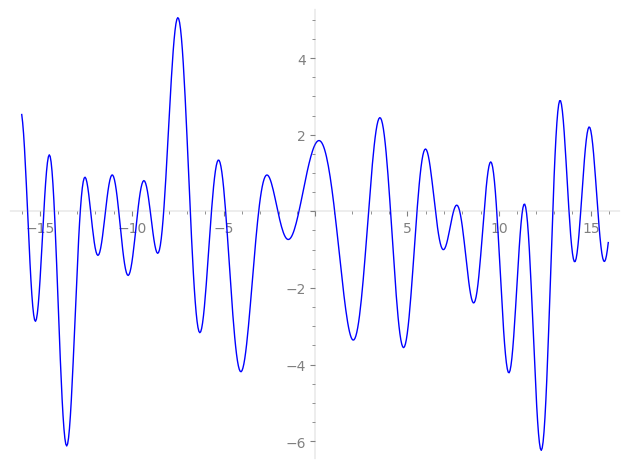| L(s) = 1 | + (−1.29 − 2.23i)2-s + (0.659 − 1.14i)4-s + (2.5 − 4.33i)5-s + (11.4 + 19.8i)7-s − 24.0·8-s − 12.9·10-s + (5.54 + 9.59i)11-s + (5.81 − 10.0i)13-s + (29.5 − 51.2i)14-s + (25.8 + 44.7i)16-s − 10.0·17-s + 117.·19-s + (−3.29 − 5.70i)20-s + (14.3 − 24.8i)22-s + (86.2 − 149. i)23-s + ⋯ |
| L(s) = 1 | + (−0.456 − 0.791i)2-s + (0.0824 − 0.142i)4-s + (0.223 − 0.387i)5-s + (0.618 + 1.07i)7-s − 1.06·8-s − 0.408·10-s + (0.151 + 0.263i)11-s + (0.124 − 0.215i)13-s + (0.564 − 0.978i)14-s + (0.404 + 0.699i)16-s − 0.143·17-s + 1.42·19-s + (−0.0368 − 0.0638i)20-s + (0.138 − 0.240i)22-s + (0.781 − 1.35i)23-s + ⋯ |
\[\begin{aligned}\Lambda(s)=\mathstrut & 405 ^{s/2} \, \Gamma_{\C}(s) \, L(s)\cr =\mathstrut & (0.173 + 0.984i)\, \overline{\Lambda}(4-s) \end{aligned}\]
\[\begin{aligned}\Lambda(s)=\mathstrut & 405 ^{s/2} \, \Gamma_{\C}(s+3/2) \, L(s)\cr =\mathstrut & (0.173 + 0.984i)\, \overline{\Lambda}(1-s) \end{aligned}\]
Particular Values
| \(L(2)\) |
\(\approx\) |
\(1.762961602\) |
| \(L(\frac12)\) |
\(\approx\) |
\(1.762961602\) |
| \(L(\frac{5}{2})\) |
|
not available |
| \(L(1)\) |
|
not available |
\(L(s) = \displaystyle \prod_{p} F_p(p^{-s})^{-1} \)
| $p$ | $F_p(T)$ |
|---|
| bad | 3 | \( 1 \) |
| 5 | \( 1 + (-2.5 + 4.33i)T \) |
| good | 2 | \( 1 + (1.29 + 2.23i)T + (-4 + 6.92i)T^{2} \) |
| 7 | \( 1 + (-11.4 - 19.8i)T + (-171.5 + 297. i)T^{2} \) |
| 11 | \( 1 + (-5.54 - 9.59i)T + (-665.5 + 1.15e3i)T^{2} \) |
| 13 | \( 1 + (-5.81 + 10.0i)T + (-1.09e3 - 1.90e3i)T^{2} \) |
| 17 | \( 1 + 10.0T + 4.91e3T^{2} \) |
| 19 | \( 1 - 117.T + 6.85e3T^{2} \) |
| 23 | \( 1 + (-86.2 + 149. i)T + (-6.08e3 - 1.05e4i)T^{2} \) |
| 29 | \( 1 + (-89.1 - 154. i)T + (-1.21e4 + 2.11e4i)T^{2} \) |
| 31 | \( 1 + (70.2 - 121. i)T + (-1.48e4 - 2.57e4i)T^{2} \) |
| 37 | \( 1 - 250.T + 5.06e4T^{2} \) |
| 41 | \( 1 + (-180. + 313. i)T + (-3.44e4 - 5.96e4i)T^{2} \) |
| 43 | \( 1 + (-180. - 312. i)T + (-3.97e4 + 6.88e4i)T^{2} \) |
| 47 | \( 1 + (300. + 519. i)T + (-5.19e4 + 8.99e4i)T^{2} \) |
| 53 | \( 1 + 201.T + 1.48e5T^{2} \) |
| 59 | \( 1 + (-207. + 360. i)T + (-1.02e5 - 1.77e5i)T^{2} \) |
| 61 | \( 1 + (-27.3 - 47.3i)T + (-1.13e5 + 1.96e5i)T^{2} \) |
| 67 | \( 1 + (-265. + 459. i)T + (-1.50e5 - 2.60e5i)T^{2} \) |
| 71 | \( 1 - 933.T + 3.57e5T^{2} \) |
| 73 | \( 1 + 560.T + 3.89e5T^{2} \) |
| 79 | \( 1 + (405. + 702. i)T + (-2.46e5 + 4.26e5i)T^{2} \) |
| 83 | \( 1 + (-269. - 466. i)T + (-2.85e5 + 4.95e5i)T^{2} \) |
| 89 | \( 1 + 686.T + 7.04e5T^{2} \) |
| 97 | \( 1 + (357. + 618. i)T + (-4.56e5 + 7.90e5i)T^{2} \) |
| show more | |
| show less | |
\(L(s) = \displaystyle\prod_p \ \prod_{j=1}^{2} (1 - \alpha_{j,p}\, p^{-s})^{-1}\)
Imaginary part of the first few zeros on the critical line
−10.71557291909569432062262385286, −9.680004430075025725644371110276, −8.997957079093037564436216190591, −8.266881974465515637421131142219, −6.81786012983747723282525547457, −5.66442700022471041518212490021, −4.89367165732304538371634187047, −3.09325254621515075778209379249, −2.04837573381708597743935586071, −0.898097363904004679357912518585,
1.04656788045226044229322834463, 2.89355350135783222998598041858, 4.09028969771938343144417076991, 5.53069238968657897966893684976, 6.53829152378334720035292922936, 7.52205351350530879758988650098, 7.85783933925918910048124937291, 9.188615980609972601371980205757, 9.875116775668530232380435138556, 11.27040484114700649437261921582

